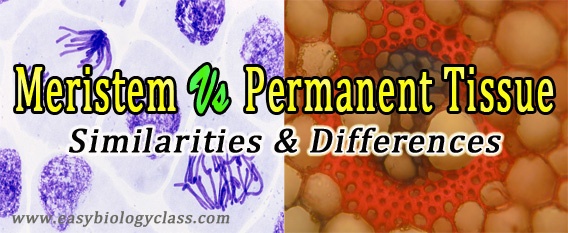Meristematic vs Permanent Tissues
Tissue is a group of cells with more or less common origin and doing a specific function. Plant tissues are broadly classified into two categories based on their capacity of cell division. They are (1) Meristematic tissues and (2) Permanent tissues. Meristem is a type of tissue system in plants, composed of a mass of undifferentiated cells and their primary function is to take part in the growth of plants. The present article discusses the Difference between Meristematic Tissue and Permanent Tissue.
Permanent tissues are differentiated tissues doing specific functions such as conduction, providing mechanical support or carrying out photosynthesis etc. Permanent tissues are originated and differentiated from meristematic tissues.
In this post we will discuss about the similarities and differences between two fundamentally different tissue systems namely Meristematic tissues and Permanent tissues.
Similarities between Meristematic Tissue and Permanent Tissue
Ø Both are tissue systems in plants
Ø Both composed of group of cells, doing specific function
Ø Meristematic tissues and some permanent tissues (parenchyma) are homogenous with a single type of cells
Difference between Meristematic Tissue and Permanent Tissue
Meristematic Tissues
(1). Meristematic tissue composed of undifferentiated cells
(2). Meristems will be always a simple tissue, composed of only one type of cells
(3). Cells are always living
(4). Cells always contain dense cytoplasm
(5). Cells always contain prominent nucleus
(6). Cells divide very rapidly
(7). Cells are smaller and isodiametric in shape with large lumen
(8). Cells are compactly packed without inter-cellular spaces
(9). Cells usually lack vacuoles
(10). Cells show very high rate of metabolism
(11). Cell wall very thin and cellulosic
(12). Cells do not undergo secondary thickening
(13). Lignified secondary cell wall completely absent
(14). Cells only contain primary pit fields
(15). Cellular inclusion and ergastic substances completely absent in the cells
(16). Cells do not store reserve food materials
(17). Meristematic tissues produce permanent tissues
(18). Meristematic tissues are restricted to certain parts of plant body
(19). Example: Root apex, Shoot apex
(20). Primary function of meristem is to assist in plant growth

Permanent Tissues
(1). Permanent tissue composed of differentiated cells
(2). Permanent tissues may be simple tissue or complex tissues (usually complex tissue, containing more than one type of cells, example: xylem, phloem)
(3). Cells may be living (Parenchyma and Collenchyma) or non-living (Sclerenchyma)
| You may also like NOTES in... | ||
|---|---|---|
| BOTANY | BIOCHEMISTRY | MOL. BIOLOGY |
| ZOOLOGY | MICROBIOLOGY | BIOSTATISTICS |
| ECOLOGY | IMMUNOLOGY | BIOTECHNOLOGY |
| GENETICS | EMBRYOLOGY | PHYSIOLOGY |
| EVOLUTION | BIOPHYSICS | BIOINFORMATICS |
(4). Cells may or may not contain cytoplasm (Parenchyma contain cytoplasm, Sclerenchyma do not contain cytoplasm)
(5). Prominent nucleus present in some cells (Parenchyma) absent in others (Sclerenchyma)
(6). Cells do not divide, they are completely differentiated
(7). Cells are larger, varying in shape with very wide or very narrow lumen
(8). Cells loosely packed in parenchyma and compactly packed in sclerenchyma
(9). Living cells are vacuolated but dead cells are devoid of protoplasm
(10). Metabolic rate usually very less or no metabolism at all
(11). Cell wall cellulosic (Parenchyma and Collenchyma) or lignified (Sclerenchyma)
(12). Cells may or may not undergo secondary thickening
(13). Lignified secondary cell wall sometimes present (as in Sclerenchyma)
(14). Cells usually contain many advanced types of pits
(15). Ergastic substances and cellular inclusion usually present
(16). Some cells store reserve food materials such as starch
(17). Permanent tissues are derived from meristematic tissues
(18). Permanent tissue are found throughout the plant body
(19). Example: Xylem, Phloem, Mesophyll
(20). Primary function varies with tissue types. It may be conduction, provide mechanical support, or carryout photosynthesis
| You may also like... | ||
|---|---|---|
| NOTES | QUESTION BANK | COMPETITIVE EXAMS. |
| PPTs | UNIVERSITY EXAMS | DIFFERENCE BETWEEN.. |
| MCQs | PLUS ONE BIOLOGY | NEWS & JOBS |
| MOCK TESTS | PLUS TWO BIOLOGY | PRACTICAL |
